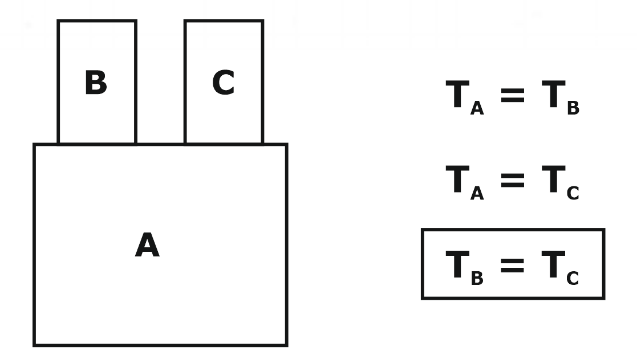ZEROTH LAW OF THERMODYNAMICS
- It is the basic law of thermodynamics which defines the temperature.
- It defines that “If thermal equilibrium of body P exists with a body Q and body R separately, then there must be thermal equilibrium between Q and R also”.
It is the basis of temperature measurement.

Thermometric Property
To obtain a quantitative measure of temperature, a reference body is used, and a physical parameter of the body which varies with temperature is selected. The selected parameter is called the thermometric property, and the reference body used for the determination of temperature is known as the thermometer.
Variables which are used to determine the temperature is known as Thermometric property.
(i). Constant Volume thermometer:
From ideal gas equation
For constant volume: P α T, So T= f(P) Only
i.e. temperature is only dependent on pressure, thus for constant volume thermometer Pressure, P will be thermometric property.
(ii). Constant Pressure thermometer:
From ideal gas equation:
For constant Pressure: V α T, So T= f(V) Only
i.e. temperature is only dependent on Volume, thus for constant Pressure thermometer Volume, V will be the thermometric property.
(iii). The thermometric property, for an electrical resistance thermometer, is resistance.
(iv). In case of Thermocouple, Voltage or EMF will be thermometric property.
(v). In case of the thermometer, length or Volume will be thermometric property.
These all are linearly varying.
Thus, T = a.N where a is a random constant.
& N is the thermometric property
Five different kinds of the thermometer, each with its own thermometric property:
Energy
(i). In a thermodynamic system, Energy interaction can be in three ways namely work, heat, and by mass.

(ii). There is only work transfer and Heat transfer interaction between a closed system and surroundings without any mass transfer, while work, Heat, and mass transfer interaction all occur in the open system (because mass also carries energy).
First Law of Thermodynamics
- The first law of thermodynamics is to relate the various form of energy and energy interaction.
- Its states that “In a process the creation or destruction of energy is impossible but it can be changed from one form to another form” and it is known as the “Conservation of energy principle”.

From the above statement, we can say that energy leaving the system must be equal to the energy supplied to the system.
Ein = Eout
FIRST LAW FOR A CLOSED SYSTEM UNDERGOING A CYCLE
As per the first law for a closed system undergoing a cycle, net heat interaction in a cycle is equal to the net Work interaction.
where J is the Joule’s equivalent. This is also expressed in the form
Fig.1: Closed System Undergoing A Cycle
1st LAW FOR A CLOSED SYSTEM UNDERGOING A CHANGE OF STATE (for a process):
The expression:
The above equation is applicable only to systems undergoing cycles, and the algebraic sum of all energy interaction across system boundaries is zero.
If both heat transfer and work transfer are involved in a change of state of the system, then the net energy transfer will be stored or accumulated within the system.
If heat transferred to the system is Q and work transferred from the system is W, during the process
Then, net energy transfer (Q – W) will be stored in the system.
Energy in storage in not in the form of heat and work and it is simply the energy of the system, thus referred as the internal energy of the system.
Therefore: Q – W – ΔE
where ΔE: Increase in the energy of the system.
Q = ΔE + W
Consequences of 1st Law of Thermodynamics
(i) Heat is a path function.
(ii) Energy-a property of the system.
(iii) Energy of isolated system is Constant.
(iv) Perpetual motion machine of first kind-PMM1 is not possible.
No comments:
Post a Comment
Knowing brings controversy